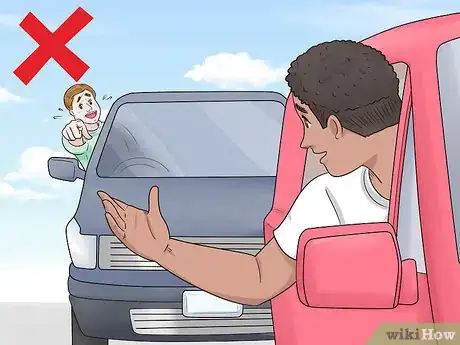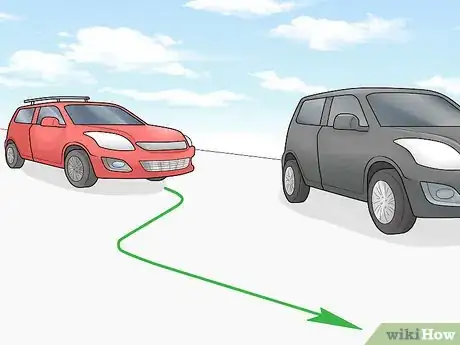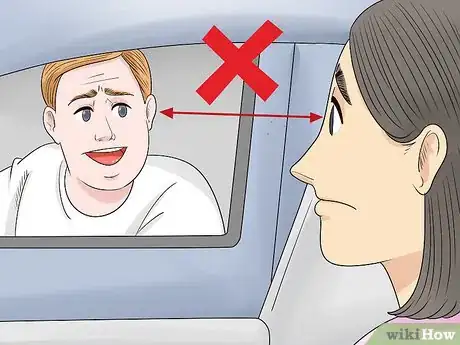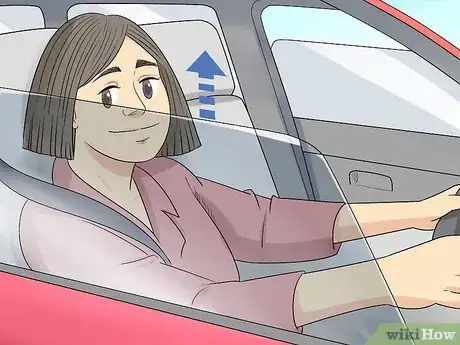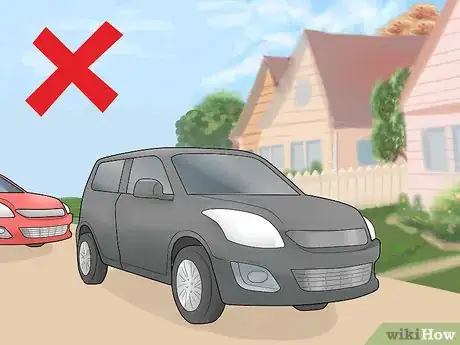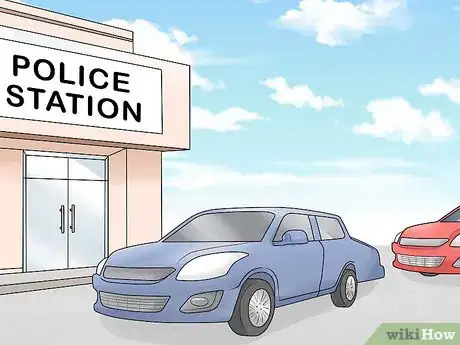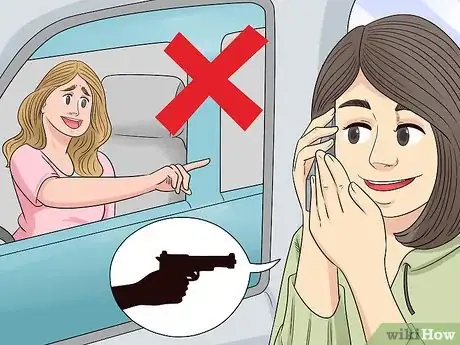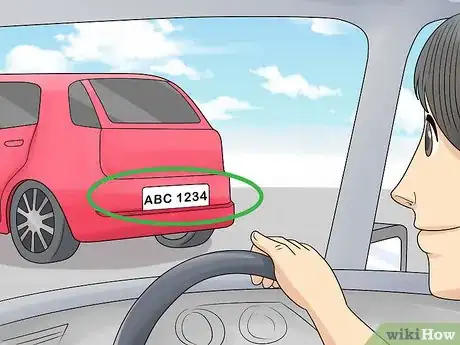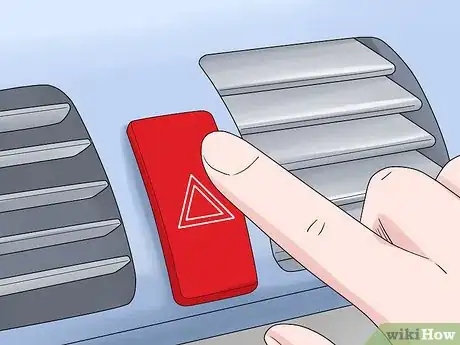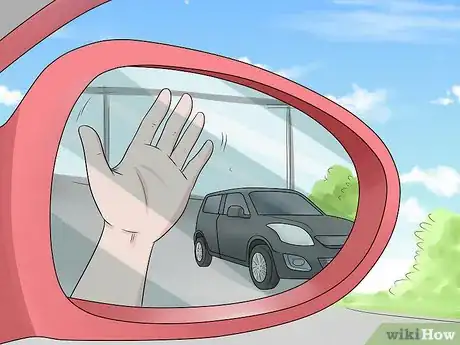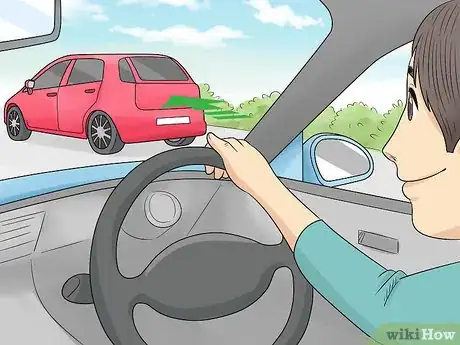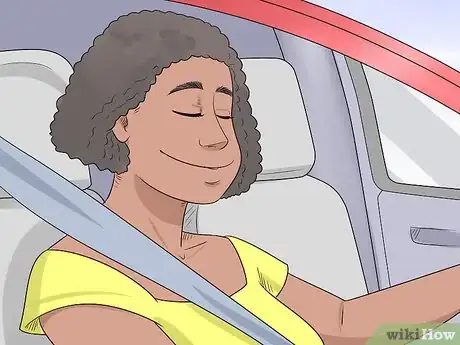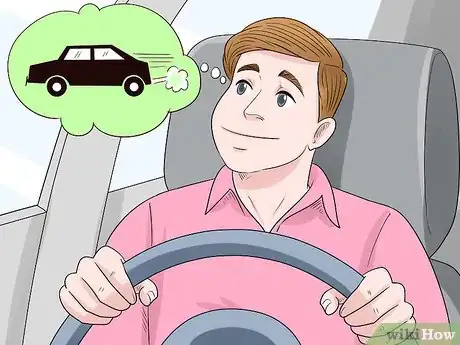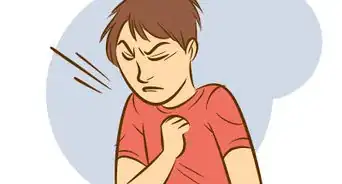This article was co-authored by Adrian Tandez. Adrian Tandez is the founder and head instructor of the Tandez Academy, a world-renowned self-defense training center in Mountain View, California. Trained under the renowned martial artist Dan Inosanto, Adrian is a certified instructor in Bruce Lee's Jeet Kune Do, Filipino Martial Arts, and Silat, among other things. Adrian has over 27 years of self defense training experience.
This article has been viewed 116,047 times.
Most drivers have cut someone off, slowed traffic, or somehow angered another driver at some point. In many stressful road situations, unfortunately, a simple error can trigger disproportionately angry and dangerous responses from other drivers. By minimizing conflict, calling for help, and de-escalating anger, you can protect yourself from the dangers of road rage related violence.
Steps
Avoiding Direct Conflict
-
1Don't engage. If you find yourself in a potential or actual conflict with another driver, back off and give them some space on the road. If the other driver begins to drive recklessly, slow down and change your route. You want to stay calm and avoid getting into a traffic accident with this person.
- Remember that an angry driver is dangerous. They can cause significant harm with their car. In some cases, a driver may even be carrying a weapon. Regardless of whether you feel confident that you are in the right, it is incredibly dangerous to engage and escalate an argument in cases of road rage.[1]
EXPERT TIPAdrian Tandez is the founder and head instructor of the Tandez Academy, a world-renowned self-defense training center in Mountain View, California. Trained under the renowned martial artist Dan Inosanto, Adrian is a certified instructor in Bruce Lee's Jeet Kune Do, Filipino Martial Arts, and Silat, among other things. Adrian has over 27 years of self defense training experience.Self Defense Trainer
 Adrian Tandez
Adrian Tandez
Self Defense TrainerEscape the situation if you can. Adrian Tandez, a self-defense expert, says: “If you find yourself in a fight with someone, get out of the situation if you can. Escape and avoid the fight as much as possible. If you can’t escape and you’re forced to fight someone like an aggressive driver, then you’re forced to defend yourself.”
-
2Let the angry driver pass. You can avoid road rage or reduce the chance that anger will grow by putting distance between yourself and the other driver. Let other cars into your lane to create a buffer between you and the angry driver.Advertisement
-
3Avoid eye contact. In the midst of a heated exchange, eye contact can escalate anger. The other driver may mistake eye contact as a taunt or a personal affront regardless of your intentions. As you allow the other driver to pass, keep your eyes on the road ahead of you.
-
4Stay in your car. Roll-up your windows and lock your doors. This will put a fairly strong barrier between you and the other motorist. This alone does not ensure your safety, but a buffer can deter or slow an attacker.
- Remember that the other driver may already be angry from another experience. Their anger may be displaced, but it can be dangerous. Do not try to reason with a person expressing road rage.
-
5Do not lead an angry driver to your home. If you are still moving and the other driver begins to follow you, do not drive to your home or place of work. Keep a distance between an enraged driver and yourself and prevent them from learning where they can find you.
-
6Seek a safe place. If the other driver is aggressively pursuing you, look for a safe neutral place that will get you out of traffic. A police station or a fire department is a good option. If you cannot find one, look for a parking lot of a busy shopping center. Do not drive home or into enclosed spaces such as parking structures.
Calling for Help
-
1Call the police. When road rage poses a danger to you or other drivers, call 911 or dial 411 and ask to be connected to the local police department dispatch. Since it can take several minutes for responders to arrive, it is important to call as soon as a dangerous situation becomes evident.
- If road rage is limited to angry gestures, it is likely that you do not need to call the police. If an angry driver follows you or directly threatens you, it is appropriate to report the incident. In these situations, you are the best authority regarding whether the other driver is a danger that should be reported to the police. Trust your instinct.
- If you are regularly in heavy traffic or anticipate being on congested roadways in a certain area, ask the local emergency responders the best way to reach them in an emergency. 911 may not be the most effective way to contact police from a cell phone.[2]
-
2Give the dispatcher your cell phone number. Once you connect with the dispatcher, give them your cell phone number in case you get disconnected. Give them your location, as exactly as you can.[3]
-
3Do not embellish circumstances. It may be tempting to exaggerate the danger that you face or to try to downplay your own wrong-doing in a case of road rage. Avoid this course of action as you could make the officers’ job harder and, in some circumstances, you can be arrested for filing a false police report.
-
4Get the license number. Responding police will want a description of the dangerous driver and car. If you are able, write down the license number or have a passenger do so.
- Be prepared to describe the vehicle and the driver. The police need to have accurate descriptions so that they can recognize what is happening as soon as they arrive on the scene.
-
5Attract attention with your horn and lights. It can take time for emergency responders to reach you, so address the situation. Road rage events may be difficult to reach or low on their list of priorities. If you don't think you're getting the attention that you need, keep yourself safe. If it means using your horn and turning on your hazard lights to get the attention of other motorists, do it. Your safety is more important than keeping traffic moving.
Deescalating the Situation
-
1Show remorse. If your cars are still operating in traffic, signal remorse by waving or mouthing “I’m sorry.” It is possible that you did nothing wrong, but your priority should be to deescalate the situation rather than sort out blame accurately.
- Apologize. If you are stopped and the driver approaches you, acknowledge you were wrong. Do this even if their anger is disproportionate, or if you do not think you were wrong.
-
2Let the other driver win. This is hard to do, but letting them "win" could quickly bring further problems to a short end. Your main goal should be to stay safe, rather than to win an argument. Avoid inflammatory statements, and allow the driver to feel like they have gotten what they wanted.
- Give up a parking space even if you were there first, let the other driver merge into your lane even if it isn’t their turn, give more breathing room between your cars, or leave the fast lane even if you are driving at the correct speed.
- Ignore insults. The enraged driver may insult you. Remember that they are angry and that their insults do not truly apply to you. Do not reciprocate when insulted. Calmly but assertively state that a neutral authority should resolve the conflict.
-
3Calm yourself. In some cases, you may be just as angry as the other driver. Before you engage in direct confrontation, take basic steps to calm your own nerves.
- Breathe deeply, counting each time you inhale to ten. Remind yourself of who you are beyond the stressful moment. Think about how your family, friends, or coworkers expect you to act.[4]
- Think about something that you are looking forward to. Look past the unpleasant moment and remember that it will be over soon.
-
4Analyze your driving. After the incident, when you've calmed down, reexamine the events that took place. Determine if you did anything wrong or if a specific action may have helped cause the other driver’s anger. Now that you are safe, it doesn't matter who was at fault. Simply determine if there is something that you can do differently next time to avoid triggering other motorist’s rage.
References
About This Article
Responding to a road raged driver can be frustrating and even scary, but if you stay calm and don’t engage with the person, you can stop things escalating. If you made a mistake on the road, you can apologize to the other driver by holding up your hand or mouthing that you’re sorry, but otherwise, don’t respond to their rage. Instead, lock your doors and stay in your vehicle. If the driver keeps following you, avoid leading them to your home or workplace. Go to a police station or busy public place. If you feel concerned for your safety, call the police as soon as possible. Try to get the license plate of the angry driver to report them. For more tips from our Self Defense co-author, including how to calm yourself when dealing with an angry driver, read on!
